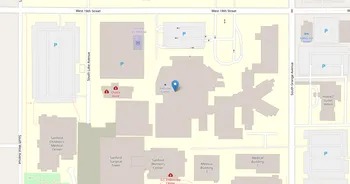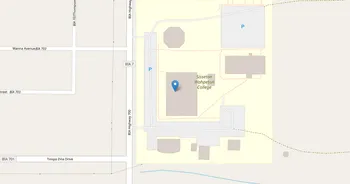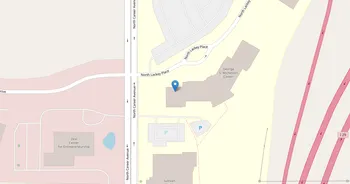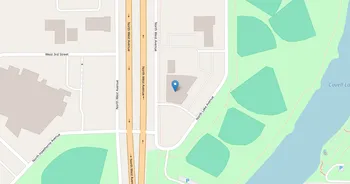University of Sioux Falls (USF) : Overview, Courses, Scholarships & Rankings
About University of Sioux Falls
Set in a leafy Sioux Falls neighborhood, the University of Sioux Falls blends a Christian liberal arts core with practical learning. It's known for small, discussion based classes and approachable faculty. Facilities include a bright library, modern labs, a chapel, fitness spaces, and residence halls. Students use advising, tutoring, writing help, counseling, and career coaching.
Campus life is lively but grounded, with music and theater, service projects, ministry groups, clubs, intramurals, and Cougar spirit. The culture leans friendly and purpose driven. Career prep grows through internships across the city's business, health care, and nonprofit circles, supported by alumni ties. And Sioux Falls adds coffee shops, an arts scene, and trails when you need a quick reset.
Key Institutional Details
Contact & Profile
Academic & Institutional
Academic Programs & Fields of Study
University of Sioux Falls (USF) offers 44 degree programs across 17 major academic fields, graduating approximately 487 students annually. The most popular fields by graduate volume are Business (6 programs, 138 graduates), Education (12 programs, 84 graduates), Health (4 programs, 58 graduates), Psychology (1 programs, 44 graduates) and Social Sciences (2 programs, 30 graduates). Explore program details, award levels, and graduate demographics below.
Business (6 programs, 138 graduates)
Business Administration, Marketing and Entrepreneurship
| Program Name | Graduates | Gender Distribution | Award Levels | CIP Code |
|---|---|---|---|---|
| Business Administration and Management | 113 |
|
Associate's
Bachelor's
Master's
|
52.0201 |
| Accounting and Business Management | 18 |
|
Bachelor's
|
52.0305 |
| Organizational Leadership | 3 |
|
Doctorate (R)
|
52.0213 |
| Entrepreneurship Studies | 2 |
|
Bachelor's
|
52.0701 |
| Accounting and Bookkeeping Technology | 1 |
|
Associate's
|
52.0302 |
| Organizational Behavior | 1 |
|
Bachelor's
|
52.1003 |
Education (12 programs, 84 graduates)
Educational Sciences, Teaching Methods and Pedagogy
| Program Name | Graduates | Gender Distribution | Award Levels | CIP Code |
|---|---|---|---|---|
| Elementary Education | 19 |
|
Bachelor's
|
13.1202 |
| Secondary Education and Teaching | 17 |
|
Bachelor's
Master's
|
13.1205 |
| Educational Leadership and Administration | 8 |
|
Master's
|
13.0401 |
| Higher Education Administration | 8 |
|
Master's
|
13.0406 |
| Instructional Technology | 8 |
|
Master's
|
13.0501 |
| Superintendency and Educational Administration | 6 |
|
Master's
|
13.0411 |
| Special Education Teaching | 6 |
|
Bachelor's
|
13.1001 |
| Reading Teacher Education | 6 |
|
Master's
|
13.1315 |
| Mathematics Teacher Education | 2 |
|
Bachelor's
|
13.1311 |
| Music Teacher Education | 2 |
|
Bachelor's
|
13.1312 |
| Art Education | 1 |
|
Bachelor's
|
13.1302 |
| History Teacher Education | 1 |
|
Bachelor's
|
13.1328 |
Health (4 programs, 58 graduates)
Healthcare Professions, Medical Sciences and Clinical Practice
| Program Name | Graduates | Gender Distribution | Award Levels | CIP Code |
|---|---|---|---|---|
| Registered Nursing | 38 |
|
Bachelor's
|
51.3801 |
| Medical Radiologic Technology | 17 |
|
Associate's
Bachelor's
|
51.0907 |
| Health Administration and Management | 2 |
|
Bachelor's
|
51.0701 |
| Clinical Laboratory Science and Medical Technology | 1 |
|
Bachelor's
|
51.1005 |
Psychology (1 programs, 44 graduates)
Psychological Sciences, Mental Health and Behavioral Studies
| Program Name | Graduates | Gender Distribution | Award Levels | CIP Code |
|---|---|---|---|---|
| General Psychology | 44 |
|
Bachelor's
|
42.0101 |
Social Sciences (2 programs, 30 graduates)
Sociology, Anthropology and Political Science Studies
| Program Name | Graduates | Gender Distribution | Award Levels | CIP Code |
|---|---|---|---|---|
| Social Sciences | 25 |
|
Associate's
Bachelor's
|
45.0101 |
| Sociology | 5 |
|
Bachelor's
|
45.1101 |
Communication (3 programs, 22 graduates)
Media Communications, Journalism and Public Relations
| Program Name | Graduates | Gender Distribution | Award Levels | CIP Code |
|---|---|---|---|---|
| Mass Communication and Media Studies | 20 |
|
Associate's
Bachelor's
|
09.0102 |
| Digital Media and Multimedia | 1 |
|
Associate's
|
09.0702 |
| Sports Communication | 1 |
|
Bachelor's
|
09.0906 |
Kinesiology (2 programs, 22 graduates)
Exercise Science, Sports Medicine and Physical Recreation
| Program Name | Graduates | Gender Distribution | Award Levels | CIP Code |
|---|---|---|---|---|
| Exercise Science and Kinesiology | 21 |
|
Bachelor's
|
31.0505 |
| Sport and Fitness Management | 1 |
|
Bachelor's
|
31.0504 |
Security & Safety (1 programs, 18 graduates)
Emergency Management, Law Enforcement and Public Safety
| Program Name | Graduates | Gender Distribution | Award Levels | CIP Code |
|---|---|---|---|---|
| Criminal Justice and Safety Studies | 18 |
|
Bachelor's
|
43.0104 |
Arts (3 programs, 18 graduates)
Fine Arts, Design Studies and Creative Performance
| Program Name | Graduates | Gender Distribution | Award Levels | CIP Code |
|---|---|---|---|---|
| Art Studies | 9 |
|
Bachelor's
|
50.0701 |
| Theatre Arts | 7 |
|
Bachelor's
|
50.0501 |
| Graphic Design | 2 |
|
Associate's
|
50.0409 |
Biological Sciences (1 programs, 11 graduates)
Life Sciences, Biotechnology and Biomedical Research
| Program Name | Graduates | Gender Distribution | Award Levels | CIP Code |
|---|---|---|---|---|
| Biology and Biological Sciences | 11 |
|
Bachelor's
|
26.0101 |
Admission Requirements & Test Scores
Comprehensive overview of admission criteria, standardized test score ranges, and application requirements for prospective students at University of Sioux Falls (USF).
Application Requirements
Data based on IPEDS for 2022-2023 academic year. Test score ranges represent the middle 50% of admitted students (25th-75th percentile). Requirements may vary by program.
Tuition, Fees & Estimated Costs
Overview of tuition rates, housing, and other annual education expenses for undergraduate and graduate students
Financial Aid & Student Support
Summary of scholarships, grants, student loans, and financial aid statistics for undergraduate students
Student Success Metrics
Graduation rates and post-graduation earnings to help assess student outcomes and long-term value of education.
Loan Burden & Repayment Outcomes
Breakdown of loan repayment rates and student debt levels by income and dependency status.
Frequently Asked Questions
Find answers to the most common questions about University of Sioux Falls (USF)
How much does it cost to attend University of Sioux Falls (USF)?
The annual tuition at University of Sioux Falls (USF) is $20,740 for in-state students. When including room and board, books, and other expenses, the total estimated cost is approximately $35,045 for in-state students. Additional costs include room and board $8,960 (on) / $10,675 (off) and books and supplies $1,000.
Data based on IPEDS program completions for 2022-2023 academic year. Tuition and cost estimates are approximate and may not include all fees, personal expenses, or transportation costs.
What academic programs and degree levels does University of Sioux Falls offer?
University of Sioux Falls (USF) offers 44 academic programs across 17 major fields of study, with available degree levels: Associate's, Bachelor's, Master's, Doctorate (Research).
Most popular program areas include:
- Business Administration, Marketing and Entrepreneurship (6 programs)
- Educational Sciences, Teaching Methods and Pedagogy (12 programs)
- Healthcare Professions, Medical Sciences and Clinical Practice (4 programs)
- Psychological Sciences, Mental Health and Behavioral Studies (1 programs)
- Sociology, Anthropology and Political Science Studies (2 programs)
Data based on IPEDS program completions for 2023-2024 academic year. Numbers reflect programs where students graduated, not all offered programs.
What is the acceptance rate for University of Sioux Falls?
University of Sioux Falls (USF) has an 82.1% acceptance rate and a 15.2% yield rate, making it moderately selective.
Admission statistics breakdown:
- Total applicants: 2,478
- Students admitted: 2,034
- Students enrolled: 310
Data based on IPEDS for 2022-2023 academic year. Admission statistics may vary by program and application cycle.
What financial aid and scholarships are available at University of Sioux Falls?
University of Sioux Falls (USF) provides financial aid to 23% of first-time, full-time students, with average grants of $11,692 and average loans of $7,795.
Average financial aid amounts by type:
- Pell grants: $4,673
- State/Local grants: $1,673
- Institutional grants: $9,709
- Federal loans: $5,072
The university supports 302 students with grants and 228 students with loans annually.
Data based on IPEDS for 2022-2023 academic year. Financial aid amounts and percentages may vary by program, enrollment status, and individual circumstances.
What is the average salary for University of Sioux Falls graduates?
University of Sioux Falls (USF) graduates earn a median salary of $46,712 after 6 years and $54,521 after 10 years.
The salary range 10 years after graduation spans from $38,541 (25th percentile) to $78,768 (75th percentile).
Data based on IPEDS for 2022-2023 academic year. Salary data reflects graduates who received federal financial aid (approximately 60% of all graduates). Actual earnings may vary significantly based on program, location, and individual circumstances.
Related Universities




Found something useful? Help others discover it too! Share with friends, on social media, or save for later - every share helps someone find the information they need.